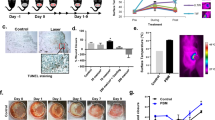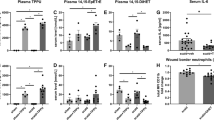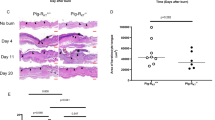Abstract
The use of systemic IGF-1 has been shown to attenuate the postburn hypermetabolic response and improve burn wound healing. Local IGF-1 gene therapy, however, promotes re-epithelialization in the burn wound without the side-effects associated with systemic delivery. We tested the hypothesis that these beneficial effects are due to changes in local cytokine production. Adult male Sprague–Dawley rats received a 40% total body surface area full-thickness scald burn and randomly received a subcutaneous injection at the burn wound margin of saline or cationic liposomes containing a IGF-1 cDNA construct. Animals were killed at 1, 4, 7 and 10 days after burn trauma. Skin biopsies at the wound border were harvested for total RNA extraction. Cytokine mRNA expression was determined using a multi-probe RNase protection assay. Data are presented as means ± s.e.m. Statistical analysis used the unpaired t-test or Mann–Whitney test where appropriate. Significance was accepted at P < 0.05. Treatment of the burn wound with liposomal IGF-1-cDNA transfer decreased IL-1β mRNA levels on day 10 after burn trauma from five-fold burn-induced increases compared with sham-treated rats, to near the control values present in unburned skin samples. Similarly, there was an eight-fold increase in TNF-α mRNA expression on postburn day 10 that was abrogated by IGF-1 gene therapy. Local IGF-1 gene transfer attenuates the mRNA expression of the inflammatory cytokines IL-1β and TNF-α in the burn wound. This change may improve burn wound healing by decreasing prolonged local inflammation. Gene Therapy (2001) 8, 1409–1415.
This is a preview of subscription content, access via your institution
Access options
Subscribe to this journal
Receive 12 print issues and online access
$259.00 per year
only $21.58 per issue
Buy this article
- Purchase on Springer Link
- Instant access to full article PDF
Prices may be subject to local taxes which are calculated during checkout





Similar content being viewed by others
References
Bistrian BR, Schwartz J, Istfan NW . Cytokines, muscle proteolysis, and the catabolic response to infection and inflammation Proc Soc Exp Biol Med 1992 200: 220–223
Beisel WR . Herman Award Lecture, 1995: infection-induced malnutrition – from cholera to cytokines Am J Clin Nutr 1995 62: 813–819
Patterson BW et al. Urea and protein metabolism in burned children: effect of dietary protein intake Metabolism 1997 46: 573–578
Ramirez RJ, Wolf SE, Herndon DN . Is there a role for growth hormone in the clinical management of burn injuries? Growth Horm IGF Res 1998 8: (Suppl. B) 99–105
Herndon DN et al. Muscle protein catabolism after severe burn: effects of IGF-1/IGFBP-3 treatment Ann Surg 1999 229: 713–720
Pejnovic N et al. Aberrant levels of cytokines within the healing wound after burn injury Arch Surg 1995 130: 999–1006
Catania RA et al. Does uninjured skin release proinflammatory cytokines following trauma and hemorrhage? Arch Surg 1999 134: 368–373; discussion 373–364
Allgower M, Schoenenberger GA, Sparkes BG . Burning the largest immune organ Burns 1995 21: S7–S47
Angele MK et al. Trauma-hemorrhage delays wound healing potentially by increasing pro-inflammatory cytokines at the wound site Surgery 1999 126: 279–285
Angele MK et al. Sex steroids regulate pro- and anti-inflammatory cytokine release by macrophages after trauma-hemorrhage Am J Physiol 1999 277: C35–C42
Huang Y et al. Effects of early eschar excision en masse at one operation for prevention and treatment of organ dysfunction in severely burned patients World J Surg 1999 23: 1272–1278
Jarrar D et al. Growth hormone attenuates the acute-phase response to thermal injury Arch Surg 1997 132: 1171–1175
Clemmons DR . Insulin-like growth factor-1 as an anabolic agent in catabolic states Ann Intern Med 1994 120: 596–597
Meyer NA, Barrow RE, Herndon DN . Combined insulin-like growth factor-1 and growth hormone improves weight loss and wound healing in burned rats J Trauma 1996 41: 1008–1012
Debroy MA et al. Anabolic effects of insulin-like growth factor in combination with insulin-like growth factor binding protein-3 in severely burned adults J Trauma 1999 47: 904–911
Bondy CA et al. Clinical uses of insulin-like growth factor I Ann Intern Med 1994 120: 593–601
Jabri N et al. Adverse effects of recombinant human insulin-like growth factor I in obese insulin-resistant type II diabetic patients Diabetes 1994 43: 369–374
Setoguchi Y, Jaffe HA, Danel C, Crystal RG . Ex vivo and in vivo gene transfer to the skin using replication-deficient recombinant adenovirus vectors J Invest Dermatol 1994 102: 415–421
Felgner PL . Nonviral strategies for gene therapy Sci Am 1997 276: 102–106
Vogt PM et al. Genetically modified keratinocytes transplanted to wounds reconstitute the epidermis Proc Natl Acad Sci USA 1994 91: 9307–9311
Eriksson E et al. In vivo gene transfer to skin and wound by microseeding J Surg Res 1998 78: 85–91
Felgner PL . Improvements in cationic liposomes for in vivo gene transfer (editorial) Hum Gene Ther 1996 7: 1791–1793
Jeschke MG et al. IGF-1 gene transfer in thermally injured rats Gene Therapy 1999 6: 1015–1020
Baserga R, Resnicoff M, D'Ambrosio C, Valentinis B . The role of the IGF-1 receptor in apoptosis Vitam Horm 1997 53: 65–98
Parrizas M, Saltiel AR, LeRoith D . Insulin-like growth factor 1 inhibits apoptosis using the phosphatidylinositol 3′-kinase and mitogen-activated protein kinase pathways J Biol Chem 1997 272: 154–161
Barreca A et al. In vitro paracrine regulation of human keratinocyte growth by fibroblast-derived insulin-like growth factors J Cell Physiol 1992 151: 262–268
Steenfos HH . Growth factors and wound healing Scand J Plast Reconstr Surg Hand Surg 1994 28: 95–105
Martin P . Wound healing – aiming for perfect skin regeneration Science 1997 276: 75–81
Hubner G et al. Differential regulation of pro-inflammatory cytokines during wound healing in normal and glucocorticoid-treated mice Cytokine 1996 8: 548–556
Fahey TJ et al. Diabetes impairs the late inflammatory response to wound healing J Surg Res 1991 50: 308–313
Salomon GD et al. The local effects of cachectin/tumor necrosis factor on wound healing Ann Surg 1991 214: 175–180
Bettinger DA et al. The role of inflammatory cytokines in wound healing: accelerated healing in endotoxin-resistant mice J Trauma 1994 36: 810–813
Ishimura K et al. Wound healing of intestinal anastomosis after digestive surgery under septic conditions: participation of local interleukin-6 expression World J Surg 1998 22: 1069–1075
Kothny-Wilkes G et al. Interleukin-1 protects transformed keratinocytes from tumor necrosis factor-related apoptosis-inducing ligand- and CD95-induced apoptosis, but not from ultraviolet radiation-induced apoptosis J Biol Chem 1999 274: 28916–28921
Postlethwaite AE et al. Modulation of fibroblast functions by interleukin 1: increased steady-state accumulation of type I procollagen messenger RNAs and stimulation of other functions, but not chemotaxis by human recombinant interleukin-1α and β J Cell Biol 1988 106: 311–318
Duncan MR, Berman B . Differential regulation of collagen, glycosaminoglycan, fibronectin, and collagenase activity production in cultured human adult dermal fibroblasts by interleukin 1-α and β and tumor necrosis factor-α and β J Invest Dermatol 1989 92: 699–706
Wassenaar A et al. CD40 engagement modulates the production of matrix metalloproteinases by gingival fibroblasts Clin Exp Immunol 1999 115: 161–167
Murphy G, Docherty AJ . The matrix metalloproteinases and their inhibitors Am J Respir Cell Mol Biol 1992 7: 120–125
Herndon DN, Wilmore DW, Mason AD Jr . Development and analysis of a small animal model simulating the human postburn hypermetabolic response J Surg Res 1978 25: 394–403
Tao Z et al. Insulin-like growth factor-I cDNA gene transfer in vitro and in vivo Biochem Genet 2000 38: 41–55
Chomczynski P, Sacchi N . Single-step method of RNA isolation by acid guanidinium thiocyanate-phenol-chloroform extraction Anal Biochem 1987 162: 156–159
Acknowledgements
The study was supported by the Clayton Foundation of Research, Houston, TX, and the Shriners Hospitals for Children.
Part of the data was presented at the 33rd Annual Meeting of the American Burn Association in Boston on 18–21 April 2001.
Author information
Authors and Affiliations
Rights and permissions
About this article
Cite this article
Spies, M., Nesic, O., Barrow, R. et al. Liposomal IGF-1 gene transfer modulates pro- and anti-inflammatory cytokine mRNA expression in the burn wound. Gene Ther 8, 1409–1415 (2001). https://doi.org/10.1038/sj.gt.3301543
Received:
Accepted:
Published:
Issue Date:
DOI: https://doi.org/10.1038/sj.gt.3301543



